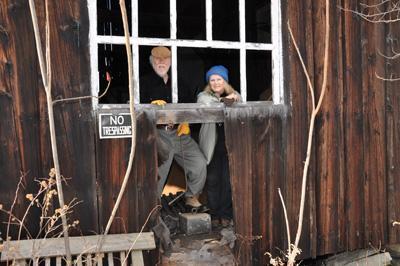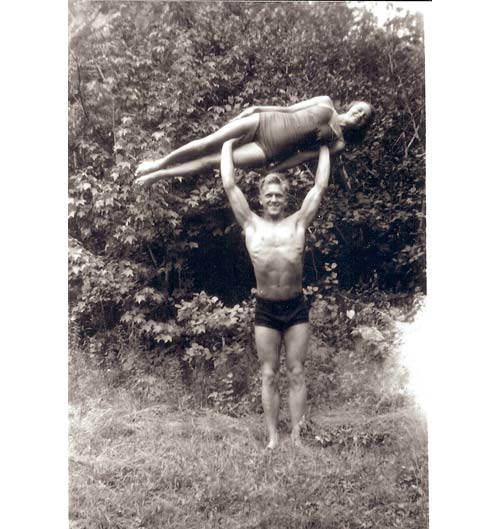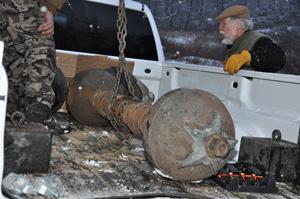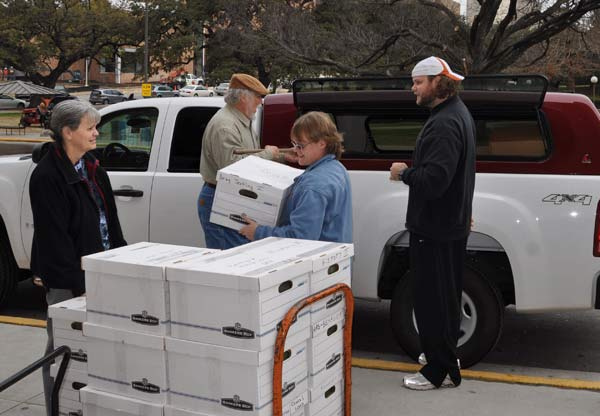Jan and I returned last night from a ten-day road trip that was one of the most interesting and rewarding we have ever made. The trip originated when Mark Henry and his wife, Jana, told us that the birth of their second child was scheduled for the morning of December 30th in New York City and that they’d like for us to be there just as we were for the arrival of their son, Jacob Todd Henry, who arrived four years and two months earlier. Accordingly, we booked plane tickets, but as we thought about the trip we began to wonder if it might be better for us to drive up to New York so that we could also drop off a large collection of nitrate-based films and film-clips in the New York area for restoration and transfer to a DVD format. Readers might wonder why we couldn’t just ship the films with our luggage, but the reason is that nitrate-based film is considered hazardous material and, as such, cannot be shipped without special permits and very expensive packaging.
In addition to our need to get the films to New York, we also realized that after the birth of Baby Henry we could drive from the New York City area over to State College, Pennsylvania, to pick up the books, files, and papers of Dr. Charles Yesalis, a prominent researcher in the area of anabolic/androgenic steroids who had recently retired from the faculty at Penn State. Probably the most widely-quoted steroid expert over the past 20 years, Dr. Yesalis had told us a month or six weeks ago that he wanted his collection to be housed at the Stark Center, and that it would fill about 40 “banker’s boxes.” What’s more, we thought, if we drove up in a truck there were several other items in the northeastern and eastern U.S. that we might be able to collect either going there or coming home.

For all those reasons, it began to seem a wiser course for us to take the time and endure the trouble of making a winter-time, holiday-season truck trip and killing with one stone at least four calling birds and perhaps as many as seven swans a-swimming, to mix and mangle a metaphor. However, what iced the winter trip (pun intended) was that just before Christmas we bought a number of items–once believed lost–that had belonged to the old Coney Island strongman Warren Lincoln Travis before he sold them to “Professor” Harry Shafran, who operated gyms in both New York City and Brooklyn before moving more than 50 years ago to rural Pennsylvania and converting a large barn into a training facility there. Jan had seen two of these items listed on eBay and, since we theorized that there were probably other things there as well, we contacted their owner, whose extended family had owned the house, barn, and land ever since Shafran’s widow had sold the property to them in the 1970s. When we learned that our theory was correct and that there were a number of additional artifacts there, as well as printed material of various sorts, we decided to try to acquire everything for the Stark Center. I explained to the owner that we operated a research library at the University of Texas in Austin, that we were almost ready to open a public museum there, and that these historic artifacts and materials–owned by both Travis and Shafran–would allow us to share the implements with the public and to tell a richer story of how the iron game had developed over the years. I also told the owner that we did not as yet have an “acquisitions budget” for the Center but that we would be buying the Travis/Shafran items personally and donating them to the university. Finally, I invited the owner to visit our website and, after he did so and discussed the situation with his son, he agreed to sell to us the two large stage weights as well as everything else related to either Travis or Shafran.
One problem was that the owner of these items believed the heaviest of the two stage bells weighed between 1500 and 2000 pounds, although it was easy to see from photographs that the only way it could weigh that much would be if it contained some sort of lead granules inside the globes, which had a diameter of approximately 18″. In order to prepare for a “heaviest case scenario” we traded in our high mileage, 1995, ¾ ton short-bed pickup for a ¾ ton, 4X4 long-bed pickup. We also rented a camper shell or cap to keep the rain and/or snow off the books, artifacts, and other materials we hoped to pack up and carry back to Texas. We made this decision so late that we only got the camper shell on Christmas Eve, but having it allowed us to pull out for points north early on Sunday morning the 27th of December.

As we planned our trip it appeared that our best route would to go to Memphis and then take Interstate 81 and travel northeast through most of the long state of Tennessee. Following that route and nearing Nashville, I decided to try one more time to reach the owner of the late, legendary deadlifter Bob Peoples’ farm in Johnson City in hopes that he would give us permission to stop by in a few hours to disassemble and pack a power rack Peoples built in his cellar in the late 1940s. This rack might seem unimportant but, as far as we can determine, the Peoples rack was the very first prototype ever built of the power racks which are now standard equipment in all modern, serious weight rooms. The trouble I’ve had over the past year or so reaching the owner to ask for the rack would take far too long to tell, but by the time we left for the trip to New York I’d reconciled myself to the fact that we’d probably never get the rack, which had been promised to us by Peoples’ widow, Juanita, more than ten years ago. Even so, I decided to make one final call, but once again all I got was a generic voice on an answering machine. Frustrated yet again, I told Jan that we just had to cross the rack off our list no matter how much we’d like to have it, but she reached for the phone and said she wanted to give it one more try. Since I know by now that readers–especially married readers–will realize where this story’s headed, I’ll simply say that the owner answered, was very friendly, and said we were more than welcome to come to the vacant farmhouse and take possession of the historic rack. So I immediately called Bill Anderson, a local schoolteacher who’d been Peoples’ longtime disciple and friend, and he agreed to meet us at the farmhouse and to bring tools and a handy friend.
Once in the cellar, it took us several hours to separate the rack from the rafters and the heavy flooring, take it apart, carry the pieces upstairs and outside, and load them into the truck; and as we worked we shared a lot of stories about Bob, including the one about how he came to meet a very young Paul Anderson, who then lived in the nearby town of Elizabethton. As this story was told I felt a sense of real reverence to be standing in the same spot where, in the very early 1950s, Paul Anderson–on his first trip down the stairs and into the cellar–answered Peoples’ question as to what weight he wanted for his first set of squats by saying, “Just put on 550” and then doing two deep, full squats to Peoples’ absolute astonishment. I could even see the exact height on the rack at which the bar would have been placed for Paul’s squats, and I’m deeply grateful to be able to display this singular artifact in our museum.
Our next stop was New York City, and I’m happy to report that Jacob Henry now has a baby sister, Joanna Lavelle, who tipped the Fairbanks at 9 pounds, 2 ounces. While in the city we also spent some time looking at photographs with Stephen Green-Armytage, a professional photographer who has done a world of work for Sports Illustrated, People, and Life magazines over the years. For example, Stephen took the photos of Jan for the 1977 Sports Illustrated article profiling her as a powerlifting pioneer as well as the shots for the 1996 People magazine article about Mark Henry’s careers in both weightlifting and powerlifting. Stephen also travelled with me to take photographs for several of my SI articles and we’ve been friends now for more than 30 years. Recently, Stephen gave his sports-related photos to the Stark Center, and when we open this spring we plan to hang an exhibition of his work in our new sports photography gallery. Stephen lives very close to one of our favorite restaurants, and so I should disclose at this point that while we were in the city we had two meals at the deservedly famous Carnegie Deli. And who knows, perhaps we even chose our hotel because the deli was less than a block away.


On the 31st we took an extra day and drove east into Connecticut to visit our old (almost-93 year-old) friend, Alton Eliason, and his remarkable, almost-95 year-old wife, Marge. Alton has been an iron gamer for almost eight decades, and for quite a few years he operated a weight-training gym and promoted lifting competitions and physical culture shows in the area. Alton was also an active collector in the field, and in the past he has given us a number of magazines, books, and artifacts for our own collection. On this visit we had a long talk at the end of which he gave us a group of spectacular photos of Pudgy Stockton taken at one of his shows along with a feed-sack full of paper material he had gotten from the late Johnny Hordines, a truly special man who held in 1938 the first truly national bodybuilding contest in the U.S. (After we work through and catalogue the Hordines material I’ll have more to say about what we find.)
Finally, after spending New Year’s Eve in North Haven, Connecticut, we woke early and drove west into the countryside around Scranton to deliver the nitrate-based film to the conservationist and to pack up the unique Travis-Shafran stage weights and related material. Just before we left Texas we’d gotten a call from the owner telling us that the snow had finally allowed him to load the two bells and take them to a scrap-yard for weighing. When he told me that the short, heavy bell weighed 1560 pounds, and that the more famous, almost seven foot barbell weighed 330 I was very glad we’d gone with the 3/4 ton pickup, especially once I lifted and loaded into the truck two square block-weights, each of which appeared to be a bit over 200 pounds. As for how we loaded it all, we put the 1560 pound, 52″ long bell sideways in the truck-bed right against the super-cab and we put one of the globes of the long bell in between the two lead-filled spheres so that its shaft was perpendicular to the heavier, shorter implement. The two big bells fit perfectly and we used pieces of the Peoples rack and the block-weights to wedge them both in place. There were other artifacts as well, but I’ll save that story for another time.
The packing of the weights took a long time since we had to go to three different locations, one of which was the old Shafran barn where we had to haul the block-weights across the barn floor, toss them through an opening in the wall, and carry them with a bent piece of rebar up a 100-foot hill to the truck…in heavy snow. Writing the last line makes me feel like the old man telling his grandson about walking five miles barefoot to school through a blizzard, but it really was a very cold day and there was well over a foot of snow down. As for the truck, it handled the weight with no problem, and the 4-wheel drive took us through and over the snowy roads and then to downtown Scranton. Since we’d been too busy to eat lunch we treated ourselves and the father-son owners to a first-rate, belt-busting meal at Cooper’s Seafood House, a large and memorable restaurant. Thus it was that long before midnight on the first day of 2010 we fell into bed pleasantly tired, full of good food and plans about how to display the exceptional artifacts which were safely stored in our sturdy truck. It was New Year’s Day, my birthday…the best one I’ve ever had.
When we got up the following morning, a severe cold front had arrived bringing 50 mile winds and horizontal snow. After waiting an hour or so for the blizzard to abate, we headed west toward State College hoping our four-wheel drive would help offset my rusty winter-driving skills. But the drive was uneventful, and even beautiful, and the heavy truck rolled down the road bulling its way through the gusting wind. Once in State College, we had lunch with another of our Penn State professor/donor pals, Dr. Ron Smith and his wife Sue, who have donated more than 700 books to our holdings over the years; and we arrived at Dr. Yesalis’s home in mid-afternoon. He had stored the 40 boxes of books and related files in the cellar, and after noting how large a pile they made we doubted that they’d all fit but decided to pack as many as we could into the truck and to ship the rest. So, after placing four or five of the boxes down among the various weights and rack boards to create a somewhat level grouping of items, we drove to a local store and bought a 4×8 piece of poster-board and put it on top of the weights, boxes, and other items as a base for the uniform banker’s boxes. We then began to pack–the Yesalis family and the Todds–and damned if we didn’t manage to fit every box into the truck. When we finished, the space inside the camper shell was completely filled, and our best guess is that the 40 boxes added another thousand pounds or so to our already heavy load.
Before the books were aboard, neither the truck’s springs nor its tires seemed to be overly affected by the barbells and the power rack, but the books finally sat the truck down a bit. Accordingly, our first stop the following morning was to a local service station to add some air to both our front and rear tires, the latter of which called for 80 pounds. As I was doing almost all of the snow-driving, Jan volunteered to add the extra air, but her hands and face were almost frostbitten because the wind was still howling and the machine was only half working. Unfortunately, no garages were open where we could be sure we were getting the air pressure we wanted, but she put in what we thought was close and I took it easy on the road until we came to a large truck stop and put in a bit over 80 and 50 pounds in the back and front tires, respectively. We then turned the rig south, toward home, with a truckful of treasures.
We were very lucky with the weather and the traffic all the way home just as we’d been lucky on the way up, and after a good night’s sleep in our own bed we drove to the front of the Stark Center this morning and, with the help of a forklift, an excavator, and our excited staff we offloaded the book-boxes and smaller artifacts and rolled them up the ramp to our elevator. We then lifted the long barbell out of the truck by hand, but we used the excavator to ease the 1560 pounder out of the truck-bed and the forklift to take it up the outside ramps and thus into its permanent home. Once the bells are properly cleaned according to the advice of the university’s conservation experts, they’ll be displayed in a place of honor befitting their importance and grim beauty. Once lost, now found.
 |
 |



Leave a Reply